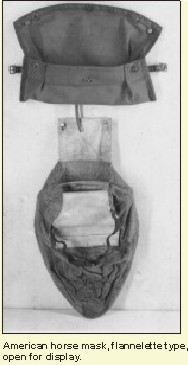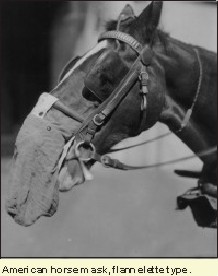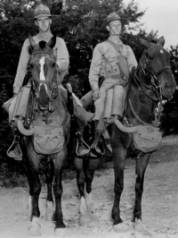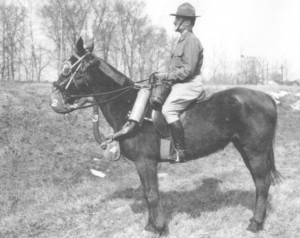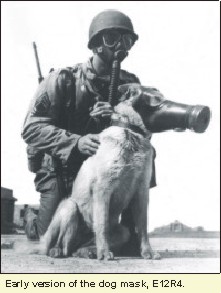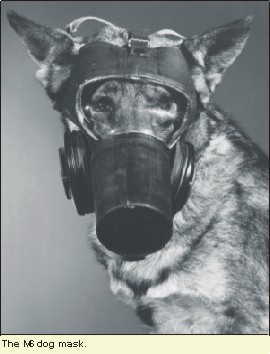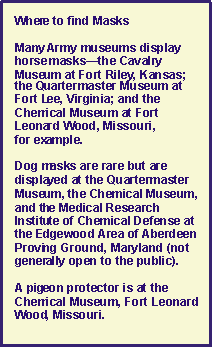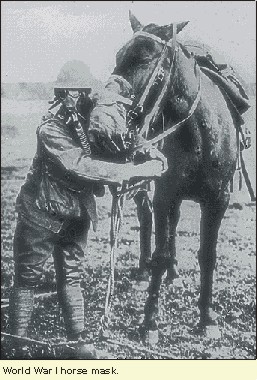 Military MilitaryMasks Animals in Chemical Warfare By Major Robert D. Walk Until recently, armies used animals to succeed on the
battlefield. Horses were used for transportation, dogs for protection
and detection, and birds for communications. At that time, the threat to
animals included pestilence and weapons of war. Because animals were
essential, armies used armor and other means to protect them as much as
possible. With the introduction of chemical warfare in World War
I, soldiers had to protect themselves and their animals in order to
survive and fight. Horses, mules, dogs, and pigeons all required
protection from the effects of chemical warfare. Each animal presented different challenges in
protection. Horses breathe through their noses, not through their
mouths, so the respirator must only cover their nostrils. Horses eyes
are not affected by lacrimators (tear agents), so eye protection
initially was not required. Dogs breathe through both their nose and
mouth so their protection must cover both. Their eyes must be protected
from the effects of lacrimators as well. Pigeons are so small that
separate respirators are only envisioned in cartoons. Pigeon protection
requires encasing the entire bird. Goats were used extensively to test chemical-agent
effects. Therefore, a means to protect goats also was created. This
article describes protection devices for horses, mules, dogs, pigeons,
and goats. Horses
and Mules The horse gas mask of World War I consisted of a large
bag that fit over the horse’s nose and mouth. The horse bit into a
canvas mouthpiece and the mask was held to the horse’s face by an
elastic band. A canvas frame attached to the mouthpiece held the mask
away from the nose so the horse couldn’t suck the mask into its nose.
The carrier, a waterproof case, was strapped to the bridle or halter.
During the war, the Fifth Avenue Uniform Company of New
York City manufactured 377,881 horse gas masks of all types. Of this
total, 351,270 were shipped overseas before Armistice Day.
The American horse gas mask (of cheesecloth) was
formally designated the MII horse gas mask in 1925. The British
flannelette-type mask was designated the MI horse gas mask. These masks
served the U.S. Army through the 1920s. The MII mask was further
modified and became the MIII horse gas mask. The MIII was essentially an
MII with a metal mouthpiece instead of a canvas one, a fitting role to
ensure a good fit, and an outlet valve.
The M4 horse gas mask adopted in 1941 represented a
radical departure from previous masks. Chemical agents were no longer
destroyed by chemicals on the mask material but were absorbed by two
large cylindrical MI canisters carried on the horse’s shoulders. The
M1 canister prevented the rifle from being positioned on the horse’s
left shoulder, which meant that the M4 mask was intended for working
horses. Two hoses carried air from the filters to a T-connection that
combined the airflow and sent it to the mask. The M4 mask was made of
rubber and completely enclosed the mouth and nose of the animal. It
included a rubber mouthpiece for the horse to bite. A mask carrier hung
from the pommel of the horse. Few of these masks were manufactured until
the need for horses in the Italian campaign created the need to protect
packhorses. The M5 and M4 horse gas masks were identical in all but
one aspect--the position of the canisters. On the M5, both canisters
hung from the right shoulder of the horse. On the M4, one canister hung
from each shoulder. The M5 mask was designed for the Cavalry. The
soldier on the horse carried his rifle in the cavalry standard on the
horse’s left shoulder. In World War II, 39,159 M4 and M5 horse gas
masks were produced.
The M4 and M5 horse gas masks survived the war as
standard issue. Experience from flying animals over the "hump"
in the China-Burma-India Theater in World War II showed that horses
needed supplied air to prevent undue physical and nervous strain. Both
horses and mules needed the air to prevent damage to themselves, the
cargo, and aircraft. In 1950, the Chemical Corps Technical Committee
determined that a suitable mask/airline adapter was required. Horses
supplied with air during the flight could be used to move equipment
immediately after landing. Tests showed that horses need 4.6 liters of
air per minute at 15,000 feet and 13.7 liters per minute at 30,000 feet
to prevent physical stress. The M6, adopted in 1951, was the final horse gas mask.
This modification of the M4 mask included a brazed-on Air Force bayonet
adapter to attach to the aircraft’s oxygen system. This allowed horses
to be transported in unpressurized aircraft (usually propeller driven)
at high altitudes without injuring or killing them from lack of oxygen
as well as to protect them against chemical agents. The mask was adopted
as the "Mask, Oxygen and Protective, Horse, M6." Within the
next decade, horses and their associated equipment were deleted from the
now mechanized and motorized Army. Dogs The dog gas mask of World War I covered the dog’s
entire head and consisted of eight layers of chemically treated
cheesecloth. It had two cellulose eye lenses to allow the dog to see,
ear pockets for the ears, space for the jaws to work, and a wide
neckband with straps to tie around the neck.
During World War II, military working dogs were used in
the theaters of war. Several experimental dog protective masks were
examined. The E12R8 and the E43R3 proved the most successful. The
facepiece of the two masks were similar except for the filter
attachment. The E12R8 used a filter mounted on the front of the mask.
The E43R3 used two Navy-civilian mask canisters mounted on the sides. Ultimately, the E43R3 was standardized as the M6 dog
gas mask. This mask used a reclaimed, coated canvas duck muzzlepiece
equipped with one large, glued- in, slightly bulged cellulose acetate
eye lens. The M6 fitted over the face and muzzle of the dog. The outlet
valve was located directly under the muzzle. It used two M12 (E40R1)
filters¾one filter positioned on either
side of the mask under the eye lens. A three-strap harness held the mask
on the dog’s head. The M8 (E10R1) carrier stored the M6 when not in
use. Thus, the mask was known as the Mask, Gas, Dog, M6-12-8. During the
war 1,409 were produced.
Pigeons
Pigeons used during World War I were protected with the
same flannelette material used in the horse gas mask. Gas-proof covers
(measuring 15 by 15 by 24 inches) of this material were used to cover
the pigeon cages in the event of a gas attack. If no covers were
available, the pigeons were released to fly above the gas cloud to
escape the effects of the gas. World War I doctrine stated that pigeons
could be used during a gas attack because they could quickly escape the
gas. Pigeons also were used for communications during World
War II. During the war, 36,000 pigeons were deployed overseas. If
chemical warfare were initiated, these pigeons had to be protected.
Three protectors were used. The M1 pigeon protective bag was large
enough to contain a small pigeon cage, and it had a hose leading to an
accordion-styled air pump with a filter canister attached. The M2,
measuring 65 by 22 by 14 inches, had a large acetate window on the side
and held a large pigeon cage. The M3 held a smaller cage and had a
window on either end. The M2 and M3 bags used a bellows attached to an
M1 training filter to supply air to the pigeon. Of these masks, only the
M2 survived the immediate aftermath of the war as standard issue. Pigeon
cages were made a standard size in the post- war years. These new cages
made the M2 pigeon protective bag impossible to use, and it was declared
obsolete in 1948. The E7 Pigeon Protective Bag was designed using the
standard pigeon containers PG-103/CB, PG-105/CB, and PG-107/CB as
models. During the next five years, various revisions of the basic
design resulted in a lightweight, durable 12 ¼- by 14 ½- by 9-inch bag
with carrying straps and a tube leading to a bellows unit with an
attached M11 filter canister. The handler pumped the bellows for five
minutes every four hours to force clean air into the protector. The
larger pigeon crates PG-49 (12 birds) and PG-50 (20 birds) required a
larger protective bag. This bag, the E8, opened to 33 by 19 by 9 inches
to accommodate the larger pigeon crates. Despite the unexplained
nonconcurrence of the Signal Corps representative, these bags were
adopted in 1951 as the M4 (former E7R2) and M5 (former E8R2). Pigeons
and their associated equipment were deleted from the inventory within
the next decade.
While not used extensively in war, the United States
used goats to test chemical-agent effects. In 1945, the United States
developed the goat gas mask. Although never formally adopted, the mask
was designated the E46. It used the Army standard M10A1 filter and was
stored in the E12 carrier. At least 25 were produced to use in agent
testing. The goat gas mask lives in the minds of most chemical soldiers
because several 1950’s vintage Army training films show goats exposed
to nerve agents. Tethered beside each other, one goat is protected and
one is not. The cannons fire, the agent cloud rolls over the goats, and
the goats are exposed to lethal concentrations of nerve agents. The
unprotected goat dies horribly from the nerve agent, but the protected
goat survives because of its E46 goat gas mask. The cessation of
open-air testing of chemical agents using goats ended the need for this
mask. Conclusion This article examined chemical-protective apparatus for
horses, dogs, pigeons, and goats. Any animals used by the military in a
chemical war must be protected to ensure their continued survival. Based
on need, the U.S. military has always protected its animal workers the
same as their human soldiers
MAJ Robert D. Walk is currently assigned to the U.S.
Army Reserve Command’s DCSOPS in the Weapons of Mass Destruction
Division. He is a graduate of Command and General Staff College and the
U.S. Army Chemical School. He is a graduate of the University of New
Hampshire with a B.S. degree in Chemical Engineering, an M.B.A. degree
from Long Island University, and an M.S. degree in Civil Environmental
Engineering from the University of Oklahoma. MAJ Walk can be contacted
through the Chemical Doctrine Net. |
